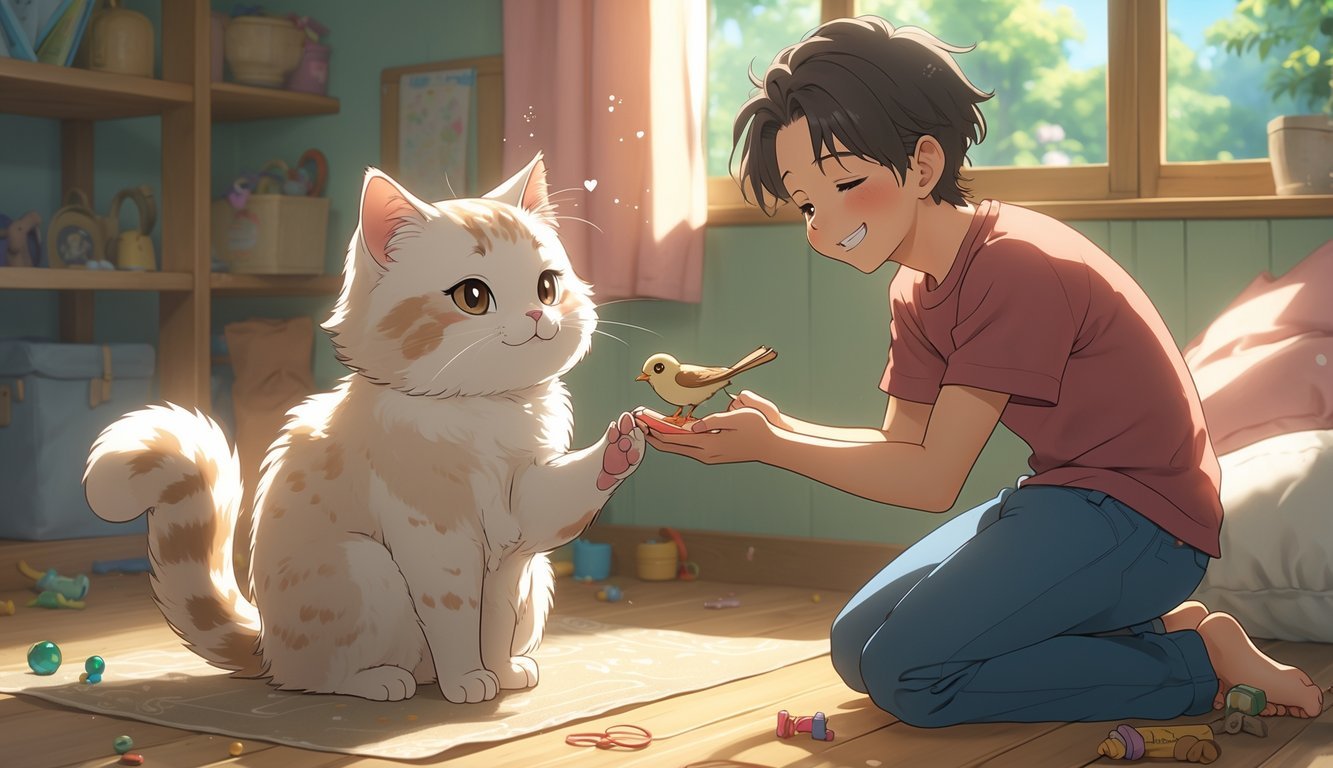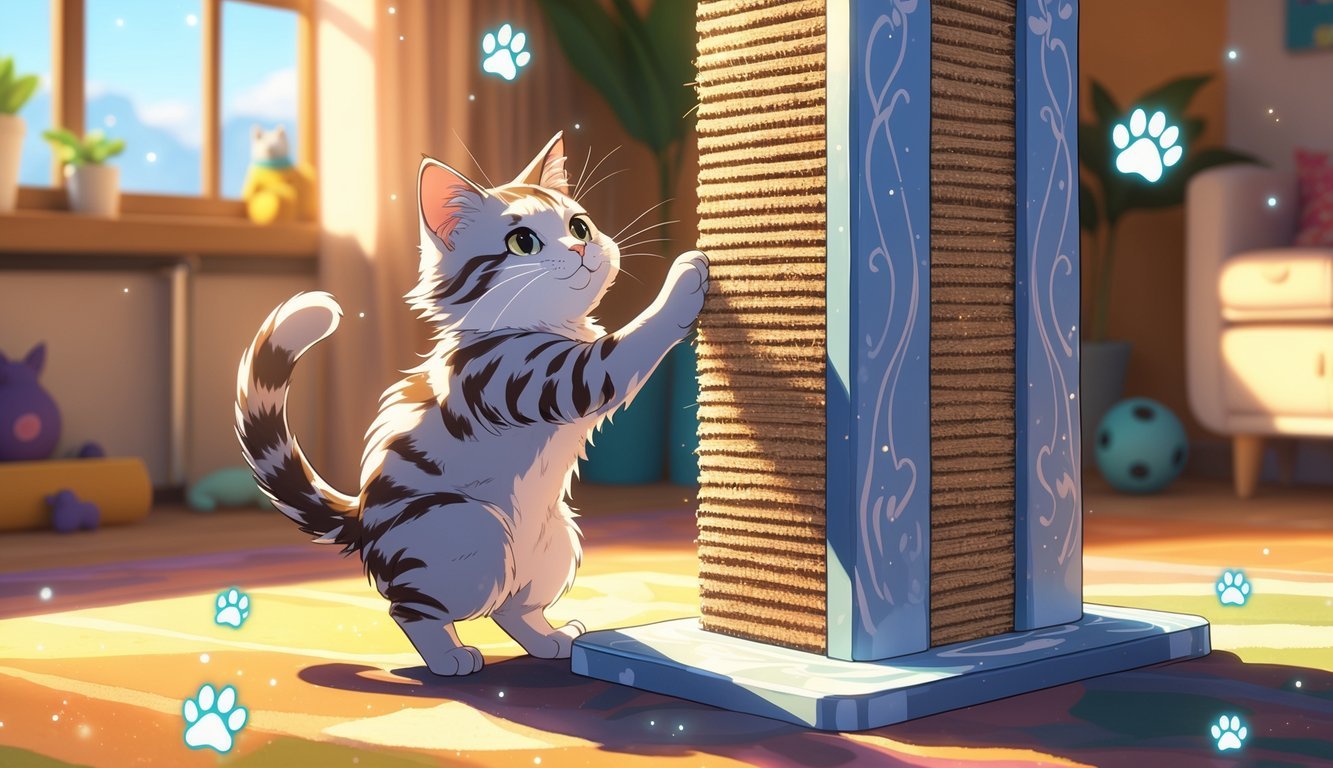PsychNewsDaily Publishers
100 Summit Drive
Burlington, MA, 01803
Telephone: (320) 349-2484
PsychNewsDaily Publishers
100 Summit Drive
Burlington, MA, 01803
Telephone: (320) 349-2484
Cats communicate through body language, vocalizations, and behaviors, revealing their emotions and needs. Understanding these signals fosters a stronger bond and enhances their well-being.

Living with a cat is a bit like sharing your place with a quiet, fuzzy enigma. You notice the purrs, those wild dashes around the house, and the odd little habits, but honestly, who really knows what’s going on in their heads sometimes?
Picking up on these hidden signals lets you meet your cat’s needs and get closer, even if they still keep a few secrets.
You don’t have to guess at every tail flick or weird routine change. Just learning a few key things can help you figure out why your cat does what it does—and how to make life smoother for both of you.

Most people think purring means a cat’s happy, right? But honestly, that’s not always the case. Cats also purr when they’re nervous, stressed out, or even feeling sick.
If your cat purrs while hiding, skipping meals, or acting off, they might be trying to calm themselves down. In those moments, purring is more like self-soothing.
Sometimes, cats purr when they’re hurting. Some folks say the vibrations help them heal or deal with pain. You might even hear your cat purring at the vet, even though they’re clearly not loving the experience.
Watch their body language. If your cat’s body looks loose and they’re slow-blinking, they’re probably content. But if they’re tense or their eyes are wide, stress might be the culprit.
If you notice purring mixed with odd behavior, pay attention. Your cat could be asking for comfort, or maybe they need a quick health check.

When your cat gives you that slow blink, it’s not just because they’re sleepy. That gentle blink says, “Hey, I trust you.”
Cats usually stay alert, so if they close their eyes around you, they feel pretty safe. It’s their way of relaxing without worrying about what’s going on.
Try slowly blinking back. Some cats love it and might blink right back at you. It’s a small thing, but it can make your bond stronger.
Not every cat does the slow blink all the time, but when yours does, it’s a quiet little “I like you.” Catching these moments helps you read your cat’s mood.

When your cat drops a dead mouse or bird at your feet, it’s a shock, for sure. But your cat isn’t trying to gross you out. They’re showing you trust and affection.
Cats learn to hunt and share from their moms. If your cat brings you prey, they see you as family—important enough to share with.
Indoor cats might just bring toys or random objects instead. It’s the same instinct, really. They want to include you in their “family business.”
Don’t scold them for it. They’re not being rude; they’re just showing love in their own weird way.
If you’d rather not get “gifts,” offer more playtime with hunting-style toys. That way, your cat still gets to act on instinct without you having to clean up surprises.

Your cat really needs a clean litter box to feel comfortable. Cats are naturally tidy, and a dirty box can make them avoid using it. That’s when accidents start happening.
If you scoop the box every day, you keep things fresh and way more inviting. It also means you won’t have to deal with a huge mess later.
Give the box a wash with mild soap and warm water once a week. Skip the strong cleaners—cats usually hate harsh smells. Just a simple routine keeps things healthier for everyone.
The type of litter matters too. Some cats like softer textures, others prefer clumping. Watch your cat’s habits to figure out what they like best.
A clean, comfy litter box fits your cat’s instincts. It’s a small thing, but it really helps your cat feel at home and less stressed.

When your cat scratches, they’re not just sharpening their claws. Their paws have scent glands, so every scratch leaves a mark and a scent. It’s how your cat says, “This is my spot.”
A scratching post gives your cat a safe way to claim territory without wrecking your furniture. It lets them do what comes naturally.
Scratching helps your cat shed the outer layers of their claws, keeping them healthy and smooth. Without a post, they’ll find something else—maybe your couch.
It’s also a good stretch and a bit of exercise. Just a few minutes on the post keeps them moving and helps their muscles.
Offering a scratching post supports your cat’s instincts and health. Plus, it saves your furniture, so it’s a win-win.

Your cat’s tail says a lot about how they’re feeling. If the tail’s straight up, your cat is probably confident or in a friendly mood. If it’s tucked low, they might be nervous.
When the tail swishes back and forth, pay attention. A slow swish usually means focus—maybe they’re watching a bug. A fast, sharp swish? That’s irritation.
Your cat’s ears also give away their mood. Ears up and forward mean curiosity. If the ears turn sideways or flatten back, your cat might be scared or annoyed.
Watch the tail and ears together. A raised tail with relaxed ears usually means your cat feels safe. But a low tail with flat ears? That’s discomfort or fear.
By noticing these little changes, you can pick up on your cat’s emotions and help them feel more secure.

Cats are big fans of routine. Regular feeding, play, and rest times help them know what’s coming next. That predictability makes them feel safe.
If you suddenly move furniture, change your work hours, or bring home a new pet, your cat can get stressed. You might see them hiding more or eating less.
Even little changes—like switching food or moving the litter box—can make your cat uneasy. They notice everything and count on things staying the same.
Try to keep routines steady. If you have to change something, do it slowly so your cat can adjust.
A stable environment with familiar smells and spots helps your cat relax. Consistency really does make a difference.

Your cat doesn’t just meow for the fun of it. Each sound usually means something, and listening helps you figure out what they want.
A short, repeated meow often signals hunger. You’ll probably hear it around mealtime or when you’re in the kitchen.
If your cat gives a long, drawn-out meow, they might be uncomfortable or annoyed. Check if their water bowl’s empty, a door’s closed, or if something else is off.
A quick, light meow is often a greeting. Some cats use it when you walk in, almost like a little “Hey!”
Pitch matters too. High-pitched meows can sound urgent, while lower ones might mean frustration. You’ll get better at telling the difference as you get to know your cat.
Every cat has their own way of “talking.” Over time, you’ll catch onto your cat’s unique sounds and what they mean.

Your cat usually picks a spot because it’s warm. Sunny windowsills, soft blankets, even your laptop—they all give off the kind of cozy heat cats love.
Safety matters too. Cats like places where they can watch what’s going on without being too exposed. High perches, couch corners, or tucked-away boxes make them feel secure.
Familiar smells help, too. If a spot smells like you or has their own scent from napping or rubbing, it feels extra safe. That’s why they keep coming back to the same places.
Watch where your cat likes to rest. Offering warm blankets, quiet corners, or safe perches gives them more cozy options.

Your cat uses both their body and their voice to let you know how they feel. Small changes in posture or sounds can tell you if they’re happy, curious, or stressed.
Your cat’s body often speaks louder than their meows. A relaxed cat might sit with paws tucked in, tail still, and eyes half-closed. If their back is arched and fur puffed up, they’re scared or defensive.
Tail position is a big giveaway:
Eyes give you clues too. A slow blink means trust, while big, wide pupils can mean excitement or fear. Ears forward show interest, but if they’re flat, your cat is probably upset or uncomfortable.
If you notice these details, you can respond better and avoid misunderstandings.
Cats use different sounds to get your attention or show how they feel. A short, soft meow usually means hello, while repeated meows can mean they want something—probably food.
Purring usually means contentment, but sometimes cats purr when they’re anxious or not feeling well. The situation matters, so check their body language too.
Some common sounds include:
Each cat has their own “dictionary” of sounds. If you listen closely, you’ll start to figure out what your cat’s trying to say and build a stronger connection.

Building a real connection with your cat honestly takes trust and a bit of patience. If you give them space when they want it and reward the behaviors you love, you’ll probably see them start to open up more.
Cats really appreciate it when you respect their boundaries. If you try to cuddle or pet them while they’re resting or hiding, they might just avoid you next time.
Let your cat decide when they want attention. You’ll notice their body language gives away a lot—ears forward, tail up, or those slow blinks usually mean they’re cool with hanging out.
But if their tail starts flicking or their ears go flat, it’s probably best to back off for a bit. It’s just how they say, “Not right now, thanks.”
Set up safe spots like a cat tree, a shelf, or even a cozy bed where they can chill out. When cats know they can leave whenever they want, they feel a lot more comfortable around you.
Give your cat control over how and when you interact. That way, they’ll start to see you as someone safe, and, honestly, they might surprise you by seeking you out more often.
Cats usually respond better when you reward their good behavior, rather than scolding them for things you don’t like. Try using tiny treats, a gentle scratch behind the ears, or maybe their favorite toy to encourage the habits you want to see.
Let’s say your cat actually uses the scratching post instead of your couch—give them a treat right away. Timing really counts here; if you praise them within a couple of seconds, they’ll start to connect their action with the reward.
You might want to try clicker training, too. When you click and then hand over a treat, your cat learns to repeat whatever they just did.
Keep training sessions pretty short, like five minutes tops. That way, you’ll both avoid getting frustrated.
If you stick with it, your cat will start to link you with good things. Honestly, isn’t that what everyone wants—a happier, closer bond with their cat?